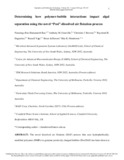JavaScript is disabled for your browser. Some features of this site may not work without it.
| dc.contributor.author | Rao Hanumanth Rao, Narasinga | |
| dc.contributor.author | Granville, Anthony M. | |
| dc.contributor.author | Browne, Christine I. | |
| dc.contributor.author | Dagastine, Raymond R. | |
| dc.contributor.author | Yap, Russell | |
| dc.contributor.author | Jefferson, Bruce | |
| dc.contributor.author | Henderson, Rita K. | |
| dc.date.accessioned | 2018-04-27T10:22:02Z | |
| dc.date.available | 2018-04-27T10:22:02Z | |
| dc.date.issued | 2018-03-06 | |
| dc.identifier.citation | Rao NR, Granville AM, Browne CI, Dagastine RR, Yap R, Jefferson B, Henderson RK, Determining how polymer-bubble interactions impact algal separation using the novel “Posi”-dissolved air flotation process, Separation and Purification Technology, Vol. 201, 7 August 2018, pp. 139-147 | en_UK |
| dc.identifier.issn | 1383-5866 | |
| dc.identifier.uri | http://dx.doi.org/10.1016/j.seppur.2018.03.003 | |
| dc.identifier.uri | http://dspace.lib.cranfield.ac.uk/handle/1826/13176 | |
| dc.description.abstract | The novel dissolved air flotation (DAF) process that uses hydrophobically-modified polymers (HMPs) to generate positively charged bubbles (PosiDAF) has been shown to separate negatively charged algal cells without the need for coagulation-flocculation. Previous research has been limited to HMPs of poly(N,N-dimethylaminoethyl methacrylate) (PDMAEMA) and, while they were effective at bench-scale, performance at pilot-scale was better using commercial poly(N,N-diallyl-N,N-dimethylammonium chloride) (PDADMAC). Hence, the aim of this research was to compare the effectiveness of PDADMAC modified with aliphatic and aromatic moieties in comparison to previously tested PDMAEMA HMPs in respect to algal cell separation and minimisation of effluent polymer concentration, as well as defining the underlying polymer-bubble interaction mechanisms. Polymer-bubble adhesion properties were measured using atomic force microscopy (AFM) while polymer concentration was monitored via zeta potential and, where possible, assays using fluorescence spectroscopy. Both PDADMAC functionalised with a fluorinated aromatic group (PDADMAC-BCF) and PDMAEMA modified with 1-bromodecane respectively, gave effective cell separation, while the treated effluent zeta potential values at maximum cell removal were lower than the other polymers trialled. The effluent polymer concentration when using PDADMAC-BCF was four times lower in comparison to another aromatically modified PDADMAC polymer. AFM studies indicated that, in contrast to the PDMAEMA-based polymers, the PDADMAC-based polymers did not adsorb closely to the bubble surface. The different polymer-bubble interactions indicate that separation mechanisms will also vary, potentially leading to differences in process effectiveness when explored at pilot scale. | en_UK |
| dc.language.iso | en | en_UK |
| dc.publisher | Elsevier | en_UK |
| dc.rights | Attribution-NonCommercial-NoDerivatives 4.0 International | * |
| dc.rights.uri | http://creativecommons.org/licenses/by-nc-nd/4.0/ | * |
| dc.subject | Algae harvesting | en_UK |
| dc.subject | Atomic force microscopy | en_UK |
| dc.subject | Gas-liquid interface | en_UK |
| dc.subject | Multiphase system | en_UK |
| dc.subject | PosiDAF | en_UK |
| dc.subject | Water treatment | en_UK |
| dc.title | Determining how polymer-bubble interactions impact algal separation using the novel "Posi"-dissolved air flotation process | en_UK |
| dc.type | Article | en_UK |
| dc.identifier.cris | 20158069 |
Files in this item
The following license files are associated with this item:
This item appears in the following Collection(s)
-
Staff publications (SWEE) [2827]

